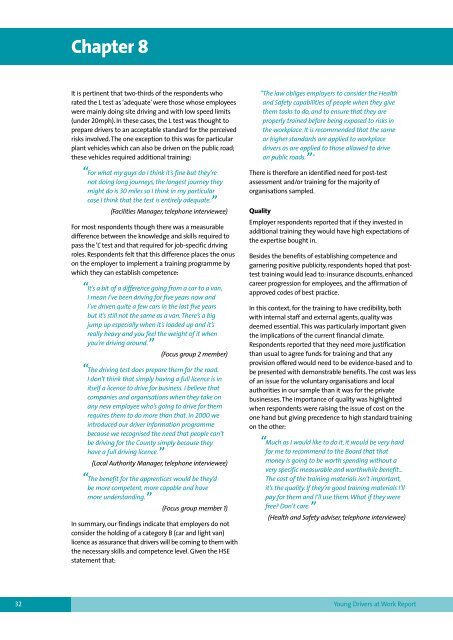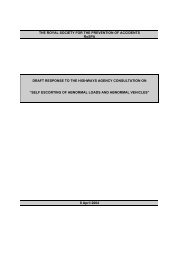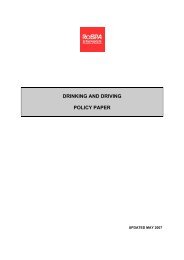RoSPA Young Drivers at Work Report
RoSPA Young Drivers at Work Report
RoSPA Young Drivers at Work Report
You also want an ePaper? Increase the reach of your titles
YUMPU automatically turns print PDFs into web optimized ePapers that Google loves.
Chapter 8<br />
It is pertinent th<strong>at</strong> two-thirds of the respondents who<br />
r<strong>at</strong>ed the L test as ‘adequ<strong>at</strong>e’ were those whose employees<br />
were mainly doing site driving and with low speed limits<br />
(under 20mph). In these cases, the L test was thought to<br />
prepare drivers to an acceptable standard for the perceived<br />
risks involved. The one exception to this was for particular<br />
plant vehicles which can also be driven on the public road;<br />
these vehicles required additional training:<br />
“For wh<strong>at</strong> my guys do I think it’s fine but they’re<br />
not doing long journeys, the longest journey they<br />
might do is 30 miles so I think in my particular<br />
case I think th<strong>at</strong> the test is entirely adequ<strong>at</strong>e. ”<br />
(Facilities Manager, telephone interviewee)<br />
For most respondents though there was a measurable<br />
difference between the knowledge and skills required to<br />
pass the ‘L’ test and th<strong>at</strong> required for job-specific driving<br />
roles. Respondents felt th<strong>at</strong> this difference places the onus<br />
on the employer to implement a training programme by<br />
which they can establish competence:<br />
“It’s a bit of a difference going from a car to a van,<br />
I mean I’ve been driving for five years now and<br />
I’ve driven quite a few cars in the last five years<br />
but it’s still not the same as a van. There’s a big<br />
jump up especially when it’s loaded up and it’s<br />
really heavy and you feel the weight of it when<br />
you’re driving around. ”<br />
(Focus group 2 member)<br />
“The driving test does prepare them for the road.<br />
I don’t think th<strong>at</strong> simply having a full licence is in<br />
itself a licence to drive for business. I believe th<strong>at</strong><br />
companies and organis<strong>at</strong>ions when they take on<br />
any new employee who’s going to drive for them<br />
requires them to do more than th<strong>at</strong>. In 2000 we<br />
introduced our driver inform<strong>at</strong>ion programme<br />
because we recognised the need th<strong>at</strong> people can’t<br />
be driving for the County simply because they<br />
have a full driving licence. ”<br />
(Local Authority Manager, telephone interviewee)<br />
“The benefit for the apprentices would be they’d<br />
be more competent, more capable and have<br />
more understanding. ”<br />
(Focus group member 1)<br />
In summary, our findings indic<strong>at</strong>e th<strong>at</strong> employers do not<br />
consider the holding of a c<strong>at</strong>egory B (car and light van)<br />
licence as assurance th<strong>at</strong> drivers will be coming to them with<br />
the necessary skills and competence level. Given the HSE<br />
st<strong>at</strong>ement th<strong>at</strong>:<br />
“The law obliges employers to consider the Health<br />
and Safety capabilities of people when they give<br />
them tasks to do, and to ensure th<strong>at</strong> they are<br />
properly trained before being exposed to risks in<br />
the workplace. It is recommended th<strong>at</strong> the same<br />
or higher standards are applied to workplace<br />
drivers as are applied to those allowed to drive<br />
on public roads. ”<br />
v<br />
There is therefore an identified need for post-test<br />
assessment and/or training for the majority of<br />
organis<strong>at</strong>ions sampled.<br />
Quality<br />
Employer respondents reported th<strong>at</strong> if they invested in<br />
additional training they would have high expect<strong>at</strong>ions of<br />
the expertise bought in.<br />
Besides the benefits of establishing competence and<br />
garnering positive publicity, respondents hoped th<strong>at</strong> posttest<br />
training would lead to: insurance discounts, enhanced<br />
career progression for employees, and the affirm<strong>at</strong>ion of<br />
approved codes of best practice.<br />
In this context, for the training to have credibility, both<br />
with internal staff and external agents, quality was<br />
deemed essential. This was particularly important given<br />
the implic<strong>at</strong>ions of the current financial clim<strong>at</strong>e.<br />
Respondents reported th<strong>at</strong> they need more justific<strong>at</strong>ion<br />
than usual to agree funds for training and th<strong>at</strong> any<br />
provision offered would need to be evidence-based and to<br />
be presented with demonstrable benefits. The cost was less<br />
of an issue for the voluntary organis<strong>at</strong>ions and local<br />
authorities in our sample than it was for the priv<strong>at</strong>e<br />
businesses. The importance of quality was highlighted<br />
when respondents were raising the issue of cost on the<br />
one hand but giving precedence to high standard training<br />
on the other:<br />
“Much as I would like to do it, it would be very hard<br />
for me to recommend to the Board th<strong>at</strong> th<strong>at</strong><br />
money is going to be worth spending without a<br />
very specific measurable and worthwhile benefit...<br />
The cost of the training m<strong>at</strong>erials isn’t important,<br />
it’s the quality. If they’re good training m<strong>at</strong>erials I’ll<br />
pay for them and I’ll use them.Wh<strong>at</strong> if they were<br />
free? Don’t care. ”<br />
(Health and Safety adviser, telephone interviewee)<br />
32 <strong>Young</strong> <strong>Drivers</strong> <strong>at</strong> <strong>Work</strong> <strong>Report</strong>
















